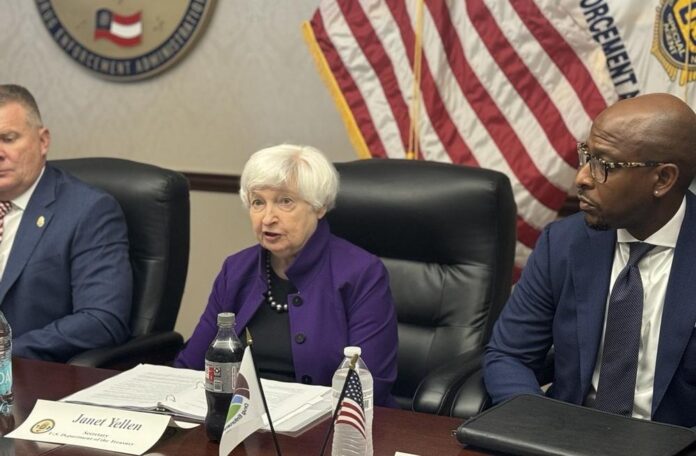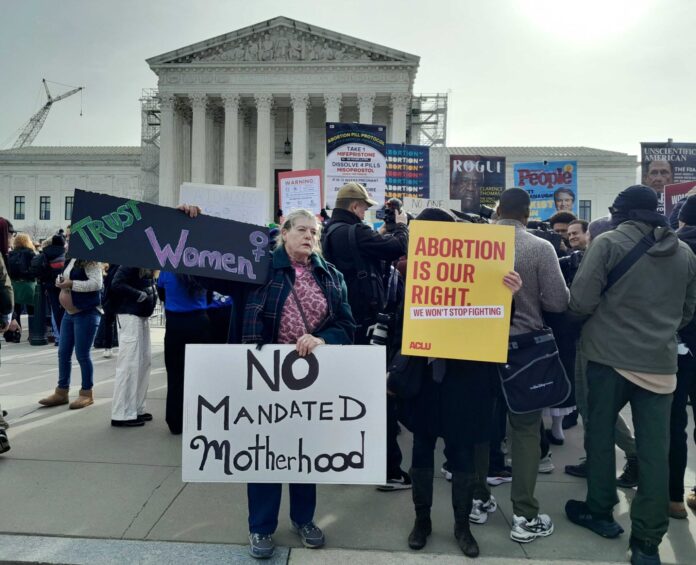WASHINGTON (States Newsroom) — Top Democratic campaign officials Thursday pressed their case for control of Congress and the White House by pointing toward the upcoming two-year anniversary of the U.S. Supreme Court overturning the constitutional right to an abortion.
More than a dozen Democrats also introduced legislation in Congress to prevent a future Republican administration from using an 1873 law, known as the Comstock Act, to bar mailing abortion medication.
On a call with reporters, the three campaign leaders said voters must flip the House from red to blue, keep Democrats in control of the Senate against the long odds and ensure President Joe Biden stays in the Oval Office to prevent the GOP from potentially implementing nationwide restrictions on reproductive rights.
Democratic National Committee Chair Jaime Harrison, Democratic Senatorial Campaign Committee Vice Chair Sen. Tina Smith of Minnesota and Democratic Congressional Campaign Committee Chair Rep. Suzan DelBene of Washington repeatedly said that Democrats would restore nationwide protections for abortion access if given unified control of government.
They, however, didn’t provide a clear road map for what Democrats would do on reproductive rights, including access to contraception and in vitro fertilization, if divided control of government continues.
Instead, they pointed to what Donald Trump, the presumptive Republican presidential nominee, might do in the event voters elect him president during November’s elections.
“We need to be clear that Trump and MAGA Republicans want to ban abortion and they have a plan to do it through executive action without any bill ever passing Congress; because they believe that politicians should have the power to make these decisions for women, whose lives and stories they will never know,” Smith said on the call.
Comstock Act fears
The Heritage Foundation, a conservative think tank, has released “Project 2025,” a lengthy document that outlines what it believes Trump should do during a second term.
The Trump campaign hasn’t endorsed the document or said it would seek to implement it in full or in part, though a former Trump administration official led its development.
The proposal includes using the Comstock Act — a law enacted more than 150 years ago to prevent the mailing of obscene materials, contraceptives and anything that could produce an abortion — to bar the shipment of medication abortion throughout the United States.
Smith on Thursday introduced a three-page bill that would eliminate that as a possibility, though the legislation may not advance in the Senate and is very unlikely to make it through the GOP-controlled House before November.
Medication abortion, which includes mifepristone and misoprostol, accounts for about 63% of abortions nationwide, according to the Guttmacher Institute. The two pharmaceuticals are also used for miscarriage care. Misoprostol has other medical uses, as well.
The Comstock Act, enacted in 1873, originally barred the mailing of materials considered lewd or obscene at the time, but is written so broadly that it has been used to bar boxing photographs, art and information about contraception.
The law explicitly prohibits mailing “every article or thing designed, adapted, or intended for producing abortion, or for any indecent or immoral use.” Smith’s bill would seek to eliminate those provisions.
Smith, when asked about the Comstock Act on the call Thursday, said the “zombie law” could be used to make medication abortion illegal without a vote in the Congress.
“It’s very clear what their plan is,” Smith said of Republicans. “And so this is another example of the very clear choice that American voters have.”
DelBene, who is leading Democrats’ campaign arm in the House, said on the call that Republicans are already trying to change when and how Americans have access to various reproductive rights by attaching amendments to the must-pass government funding bills.
“This election is fundamentally about our rights, our freedoms, our democracy and our future,” DelBene said. “House Republicans have made it clear they’re willing to do anything to take those away.”
A divided Congress predicted
The most likely outcome of November’s elections isn’t currently unified Democratic control in the eyes of some analysts however.
Three experts at Moody’s Analytics released an analysis this week, showing the most probable result is that Biden will remain president with a divided Congress.
That scenario had a 40% probability, while a Republican sweep had a probability of 35%. Trump winning the presidential election and gaining a divided Congress had a 15% probability. A Democratic sweep had a 10% probability, according to the report.
The most likely scenario of Biden remaining president with a split Congress suggests that the GOP would flip the Senate and the Democrats would regain the House of Representatives.
“With the retirement of West Virginia Democrat Joe Manchin, the deep-red state will almost surely elect a Republican senator, leaving the Senate evenly divided,” the report states. “But while recent polling shows that Senate races in Arizona, Maryland, Montana, Nevada and Ohio are close, Republicans need to take only one of these seats to regain the majority.”
“Each race has its own story, but helping the Republicans’ cause is angst over inflation and heightened concern over the immigrant crisis at the southern border,” the report adds.
The analysis goes on to say that “federal judicial decisions on redistricting efforts have also leaned in Democrats’ favor, boosting their chances” of regaining control of the House.
“Also, given that incumbents win reelection more than 90% of the time, the relatively high number of congressional retirements relative to previous cycles creates the potential for more change in the body,” the analysis states.
The report details the four outcomes of November’s election as well as the various economic scenarios that would play out under either a Biden or a Trump presidency for the next four years.
The report was written by Chief Economist Mark M. Zandi, Director/Senior Economist Brendan La Cerda and Economist Justin Begley.

















Recent Kennesaw State shooting raises question: Are we safe yet?
Before the recent shooting at Kennesaw State University hit the news, my nineteen-year-old daughter witnessed it firsthand. My husband and I were away in Austin when she called us, sobbing. After assuring us that she was physically okay, she told us of the nightmare that had just taken place before her.
She and her best friend had been spending a quiet Saturday afternoon on the ground floor of a campus dorm, when they heard several gunshots, close by.
“Mom, people asking, ‘Are those gunshots?’ Must have never heard real gunshots. There’s no mistaking them,” she cried.
Startled, my daughter and her friend looked out their window, and saw a young girl lying on the pavement nearby with “blood all over her.” My daughter called 911, and she and her friend ran to gather a washcloth and a belt. They could see that the victim’s arm had been shot, and they thought they could help by fashioning a tourniquet for the wound. But the 911 responder told them not to approach the wounded girl, for fear that the shooter might still be in the area.
So, they watched. As the girl’s bloody body twitched on the pavement, they helplessly watched her bleed her life away before first responders could reach her. And later, my husband and I listened helplessly from hundreds of miles away as our girl wept and wept and wept.
Now, the parents of that dear young woman who was shot and killed by yet another angry man with a gun received a far more devastating phone call that Saturday. But hearing about the horror that my daughter had witnessed and how it was affecting her was gut-wrenching, nonetheless.
The trauma of a nation that lives in the shadow of constant school shootings, and movie theater shootings, and club shootings, and concert shootings, and church shootings, and hospital shootings, and library shootings, and synagogue shootings and grocery store shootings and office building shootings is somehow not enough to persuade us to re-evaluate our approach to firearms. I don’t think Americans want to live this way, but there are those of us who are so fixated on what some people might possibly lose, that they have missed the magnitude of all that we have already lost.
The young woman who was shot full of bullets on a college campus and left for dead should not have been killed. My daughter and the millions of others like her who have been victimized somehow by the sudden eruption of gun violence into their lives should not have to see the same images of blood and death that soldiers on the field of war might witness. We have made our entire public life into a shooting gallery in the name of “safety” and “freedom”.
What freedom is this?
Are we safe, yet?